Research on Multiple-Factor Dynamic Constitutive Model of Poured Asphalt Concrete
Abstract
1. Introduction
2. Materials and Methods
2.1. Experimental Materials and Equipment
2.2. Experimental Content and Scheme
2.3. Hardin-Drnevich Model
3. Results and Discussion
3.1. Test Results and Analysis
3.1.1. Dynamic Stress
3.1.2. Dynamic Elasticity Modulus
3.1.3. Damping Ratio
3.2. Dynamic Constitutive Model Based on the Hardin-Drnevich Model
3.2.1. Research on Dynamic Elasticity Modulus
3.2.2. Research on the Damping Ratio
4. Conclusions
- (1)
- The variation patterns of the dynamic stress-strain backbone lines of poured asphalt concrete are basically the same, consistent with a hyperbolic curve. The confining pressure and principal stress ratio remarkably impact the backbone line of dynamic stress-strain of poured asphalt concrete. In contrast, the influence of vibration frequency is minor.
- (2)
- The curves of dynamic elasticity modulus-dynamic strain of poured asphalt concrete have similar variation trends. According to the analysis of the straight line fitting results of the inverse dynamic elasticity modulus-dynamic strain, the intercept () and slope () can be obtained, from which the maximum dynamic elasticity modulus and the ultimate stress can be derived, respectively.
- (3)
- The confining pressure and principal stress ratio have significant impacts on the maximum dynamic elasticity modulus of poured asphalt concrete. Conversely, frequency barely affects it. Subsequently, there is an evident difference between the calculated values of the original formula and the fitted values of the experimental data for the maximum dynamic elasticity modulus, with the maximum relative errors of 16.65% and 18.15%, respectively. Therefore, the expression of the maximum dynamic elasticity modulus was modified. The modified formula was used to calculate. The maximum relative errors are 3.02% and 2.04%, respectively.
- (4)
- The variation patterns of the damping ratio-dynamic strain curves of poured asphalt concrete are basically the same under the influences of confining pressure, principal stress ratio, and vibration frequency. At the initial stage of vibration, the hysteresis loop area is small. The calculated damping ratio is imprecise. After reaching a certain extent, the curve of damping ratio-dynamic strain tends to flatten. Therefore, the asymptotic constant can serve as the maximum damping ratio.
Author Contributions
Funding
Institutional Review Board Statement
Informed Consent Statement
Data Availability Statement
Conflicts of Interest
References
- Wang, W.; Hodg, K. Cyclic behavior of asphalt concrete used as impervious core in embankment dams. J. Geotech. Geoenviron. 2011, 137, 536–544. [Google Scholar] [CrossRef]
- Kim, H.S.; Ban, H.; Park, W. Deicing concrete pavements and roads with carbon nanotubes (CNTs) as heating elements. Materials 2020, 13, 2504. [Google Scholar] [CrossRef] [PubMed]
- Tang, R.; Du, Y.; Sun, Y.; Hu, Y.; Tang, W.; Yu, Z. Experimental study and failure criterion analysis of dynamic mechanical performance of hydraulic asphalt concrete under combined compression-shear stresses. Mater. Struct. 2024, 57, S11527. [Google Scholar] [CrossRef]
- Ning, Z.; Liu, Y.; Wang, W.; Dong, J.; Meng, X.; Wang, Q. Crack propagation and non-uniform deformation analysis in hydraulic asphalt concrete: Insights from X-ray CT scanning and digital volume correlation. Constr. Build. Mater. 2024, 411, 134704. [Google Scholar] [CrossRef]
- Yang, Z.; Yang, W.; Yang, H.; Liu, L.; He, J. Study of stress-strain relationship of hydraulic asphalt concrete at low to intermediate temperatures based on experimental data regression. Constr. Build. Mater. 2023, 409, 134059. [Google Scholar] [CrossRef]
- Francesca, R.; Shahin, E.; Loretta, V.; Nunzio, V. A complete study on an asphalt concrete modified with graphene and recycled hard-plastics: A case study. Case Stud. Constr. Mat. 2022, 17, E01437. [Google Scholar]
- Tang, R.; Yu, Z.; Liu, G.; Li, F.; Tang, W. Uniaxial dynamic compressive behaviors of hydraulic asphalt concrete under the coupling effect between temperature and strain rate. Materials 2020, 13, 235348. [Google Scholar] [CrossRef]
- Ning, Z.; Liu, Y.; Wang, W. Compressive behavior of hydraulic asphalt concrete under different temperatures and strain rates. J. Mater. Civil Eng. 2021, 33, 003594. [Google Scholar] [CrossRef]
- Li, Y.; Liu, J.; Liu, Y.; Zhou, H.; Wen, L.; Chen, J. Aggregate grading design of skeleton dense hydraulic asphalt concrete. Constr. Build. Mater. 2023, 365, 130031. [Google Scholar] [CrossRef]
- Laboyko, R.Y.; Vorobyov, K.M. Stress-strain state of asphalt concrete and clay-cement concrete as materials of the diaphragm of an earth-fill dam. Power Tech. Eng. 2024, 57, 557–563. [Google Scholar] [CrossRef]
- Andrii, B.; Yang, S.; Valerii, P.; Shao, M.; Ta, M. Investigation of the properties of cast asphalt concrete mixture with the addition of fiber from the fly ash of thermal power plants. Mater. Sci.-Poland 2022, 40, 125–146. [Google Scholar]
- Zhang, S.; Sha, A.; Lu, X.; Nie, W.; Li, W.; Yan, J. Nonlinear constitutive model of high-temperature viscoelastic deformation of gussasphalt concrete. Adv. Mater. Sci. Eng. 2022, 2022, 8316014. [Google Scholar] [CrossRef]
- Bai, Z.; Pei, Z.; Qiao, Y.; Cheng, P.; Guo, J.; Liu, Z.; Abdukadir, A.; Xiong, Y.; Yi, J. Study on the development and performance optimization of gussasphalt containing high percent of fine reclaimed asphalt pavement. Constr. Build. Mater. 2024, 420, 135557. [Google Scholar] [CrossRef]
- Du, J.; Li, F. Propagation characteristics of dispersion cracks in asphalt concrete at low temperatures. J. Mater. Civil Eng. 2024, 36, 17352. [Google Scholar] [CrossRef]
- Zhang, B.; Song, L.; Ji, Z.; Wang, B.; Wu, Z. Progress and prospect of geophysical research on underground gas storage: A case study of Hutubi gas storage, Xinjiang, China. Earthq. Res. Adv. 2020, 34, 187–209. [Google Scholar]
- Xue, B.; Que, Y.; Pei, J.; Ma, X.; Wang, D.; Yuan, Y.; Zhang, H. A state-of-the-art review of discrete element method for asphalt mixtures: Model generation methods, contact constitutive models and application directions. Constr. Build. Mater. 2024, 414, 134842. [Google Scholar] [CrossRef]
- Sun, H.; Jiang, P.; Ding, Y.; Pang, L.; Liu, Y.; Wang, Y.; Shang, X. Study on performance optimization of composite natural asphalt modified gussasphalt mix. Coatings 2022, 12, 78. [Google Scholar] [CrossRef]
- Zhang, Y.; Wang, W.; Zhu, Y. Investigation on conditions of hydraulic fracturing for asphalt concrete used as impervious core in dams. Constr. Build. Mater. 2015, 93, 775–781. [Google Scholar] [CrossRef]
- Chang, Z.; Liu, D.; Liang, J. Relationship between porosity and the modified constitutive model parameters of asphalt concrete core material. KSCE J. Civ. Eng. 2023, 27, 4250–4262. [Google Scholar] [CrossRef]
- Albayati, A.H.; Ajool, Y.S.; Allawi, A.A. Comparative analysis of reinforced asphalt concrete overlays: Effects of thickness and temperature. Materials 2023, 16, 5990. [Google Scholar] [CrossRef] [PubMed]
- Feizi-Khankandi, S.; Ghalandarzadeh, A.; Mirghasemi, A.; Hoeg, K. Seismic analysis of the garmrood embankment dam with asphaltic concrete core. Soils Found. 2009, 49, 153–166. [Google Scholar] [CrossRef]
- Giunta, M. One-dimensional visco-elastoplastic constitutive model for asphalt concrete. Multidiscip. Model. Mater. Struct. 2006, 2, 247–264. [Google Scholar] [CrossRef]
- Ren, J.; Zhou, H.; Ma, W.; Zhong, J. Study on elasto-plastic response of the unsupported random launching site for the missile. Adv. Mater. Res. 2014, 3227, 1274–1279. [Google Scholar] [CrossRef]
- Mirzaiyan, D.; Ameri, M.; Amini, A.; Sabouri, M.; Norouzi, A. Evaluation of the performance and temperature susceptibility of gilsonite-and SBS-modiffed asphalt binders. Constr. Build. Mater. 2019, 207, 679–692. [Google Scholar] [CrossRef]
- Al-Mansoori, T.; Norambuena-Contreras, J.; Garcia, A. Effect of capsule addition and healing temperature on the self-healing potential of asphalt mixtures. Mater. Struct. 2018, 51, 53. [Google Scholar] [CrossRef]
- Han, X.; Hu, Z.; Yu, L.; Pang, Y.; She, H.; Zhang, L.; Wang, X.; Qi, C. Dynamic characteristics of asphalt concrete as an Impervious core in embankment dams under varying temperatures and stress states. Materials 2023, 16, 6529. [Google Scholar] [CrossRef] [PubMed]
- Wang, C.; Chen, Q.; Fu, H.; Chen, J. Heat conduction effect of steel bridge deck with conductive gussasphalt concrete pavement. Constr. Build. Mater. 2018, 172, 422–432. [Google Scholar] [CrossRef]
- Zhang, J.; Zhou, M.; Liu, J.; Huang, X. Experimental study of stress and deformation of reclaimed asphalt concrete at different temperatures. Materials 2023, 16, 1323. [Google Scholar] [CrossRef] [PubMed]
- Zhang, S.; Zhang, H.; Zhou, M. Investigation on the high-temperature stability and fatigue behavior of cold mixed epoxy asphalt mixture with different gradations. Case Stud. Constr. Mat. 2024, 20, E02694. [Google Scholar] [CrossRef]
- Jin, L.; Yu, W.; Du, X.; Zhang, S.; Li, D. Meso-scale modelling of the size effect on dynamic compressive failure of concrete under different strain rates. Int. J. Impact Eng. 2019, 125, 1–12. [Google Scholar] [CrossRef]
- Wimmer, J.; Stier, B.; Simon, J.; Reese, S. Computational homogenisation from a 3D finite element model of asphalt concrete—Linear elastic computations. Finite Elem. Anal. Des. 2016, 110, 43–57. [Google Scholar] [CrossRef]
- Phuc, V.L. Performance of asphalt binder containing sugarcane waste molasses in hot mix asphalt. Case Stud. Constr. Mat. 2021, 15, E00595. [Google Scholar]
- Akhtarpour, A.; Khodaii, A. Experimental study of asphaltic concrete dynamic properties as an impervious core in embankment dams. Constr. Build. Mater. 2013, 41, 319–334. [Google Scholar] [CrossRef]
- Feng, S.; Wang, W.; Hu, K.; Höeg, K. Stress-strain-strength behavior of asphalt core in embankment dams during construction. Constr. Build. Mater. 2020, 259, 119706. [Google Scholar] [CrossRef]
- Wang, W.; Hu, K.; Shan, F.; Höeg, K. Shear behavior of hydraulic asphalt concrete at different temperatures and strain rates. Constr. Build. Mater. 2020, 230, 117022. [Google Scholar] [CrossRef]
- Fu, J.; Liu, J.; Zhang, X.; Li, L.; Ma, X.; Liu, Z. Mesoscale experimental procedure and finite element analysis for an indirect tensile test of asphalt concrete. Road Mater. Pavement 2018, 19, 1904–1925. [Google Scholar] [CrossRef]
- Zhang, Y.; Druta, C.; Wang, L.; Xiong, H.; Zhang, W. Dynamic responses of asphalt concrete slab under cyclic wheel loading using acceleration spectrum analysis. Constr. Build. Mater. 2017, 152, 134–144. [Google Scholar] [CrossRef]
- Xin, C.; Lu, Q.; Ai, C.; Ali, R.; Qiu, Y. Optimization of hard modified asphalt formula for gussasphalt based on uniform experimental design. Constr. Build. Mater. 2017, 136, 556–564. [Google Scholar] [CrossRef]
- Zhong, K.; Sun, M.; Qin, Y. Study on the rheological properties of gussasphalt after superheat aging. IOP Conf. Ser. Earth Environ. Sci. 2019, 233, 032002. [Google Scholar]
- Li, T.; Jin, Q.; Jiang, P.; Sun, H.; Ding, Y.; Yan, Z.; Shi, N. Performance optimization of modified gussasphalt binder prepared using natural asphalt. Front. Mater. 2022, 9, 840380. [Google Scholar] [CrossRef]
- Luo, S.; Qian, Z.; Yang, X.; Wang, H. Design of gussasphalt mixtures based on performance of gussasphalt binders, mastics and mixtures. Constr. Build. Mater. 2017, 156, 131–141. [Google Scholar] [CrossRef]
- Wang, H.; Li, G. Study of factors influencing gussasphalt mixture performance. Constr. Build. Mater. 2015, 101, 193–200. [Google Scholar] [CrossRef]
- Hong, C.; Guo, F. Study on high-temperature stability of composite gussasphalt concrete. Mater. Res. Innov. 2015, 19, 494–499. [Google Scholar] [CrossRef]
- Li, Z.; Guo, T.; Chen, Y.; Yang, W.; Ding, S.; Hao, M.; Zhao, X.; Liu, J. Electrode Layout optimization and numerical simulation of cast conductive asphalt concrete steel bridge deck pavement. Materials 2022, 15, 7033. [Google Scholar] [CrossRef] [PubMed]
- Hardin, B.O.; Drnevich, V.P. Shear modulus and damping in soils: Measurement and parameter effects. J. Soil Mech. Found. Div. 1972, 98, 603–624. [Google Scholar] [CrossRef]
- Yu, X.; Liu, H.; Sun, R.; Yuan, X. Improved Hardin-Drnevich model for the dynamic modulus and damping ratio of frozen soil. Cold Reg. Sci. Technol. 2018, 153, 64–77. [Google Scholar] [CrossRef]
- Hou, T.; Pei, Z.; Luo, Y.; Cui, Y. Study on the dynamic constitutive relationship of EPS particles light weight soil based on Hardin–Drnevich model. Geotech. Geol. Eng. Int. J. 2020, 38, 1785–1798. [Google Scholar] [CrossRef]


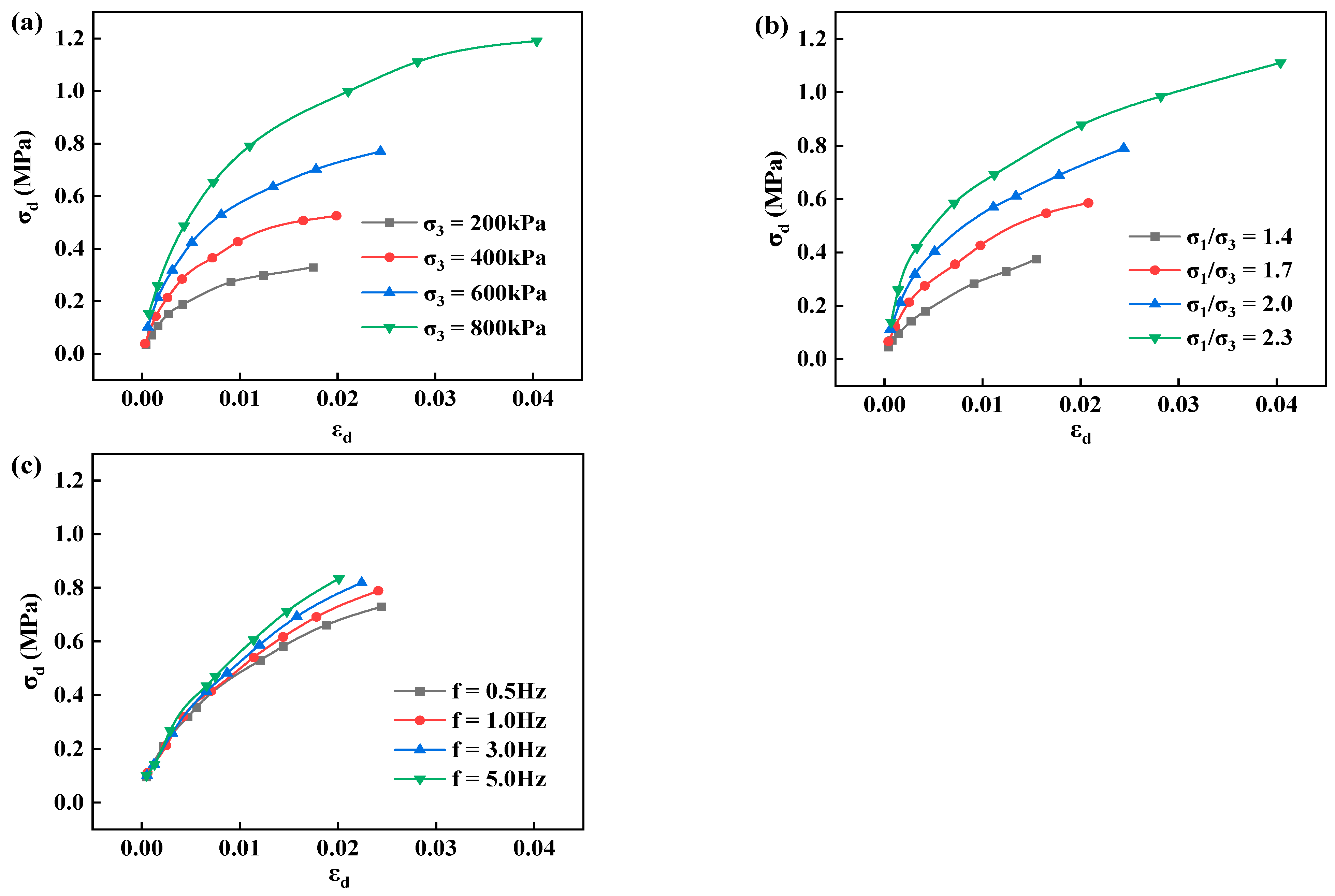
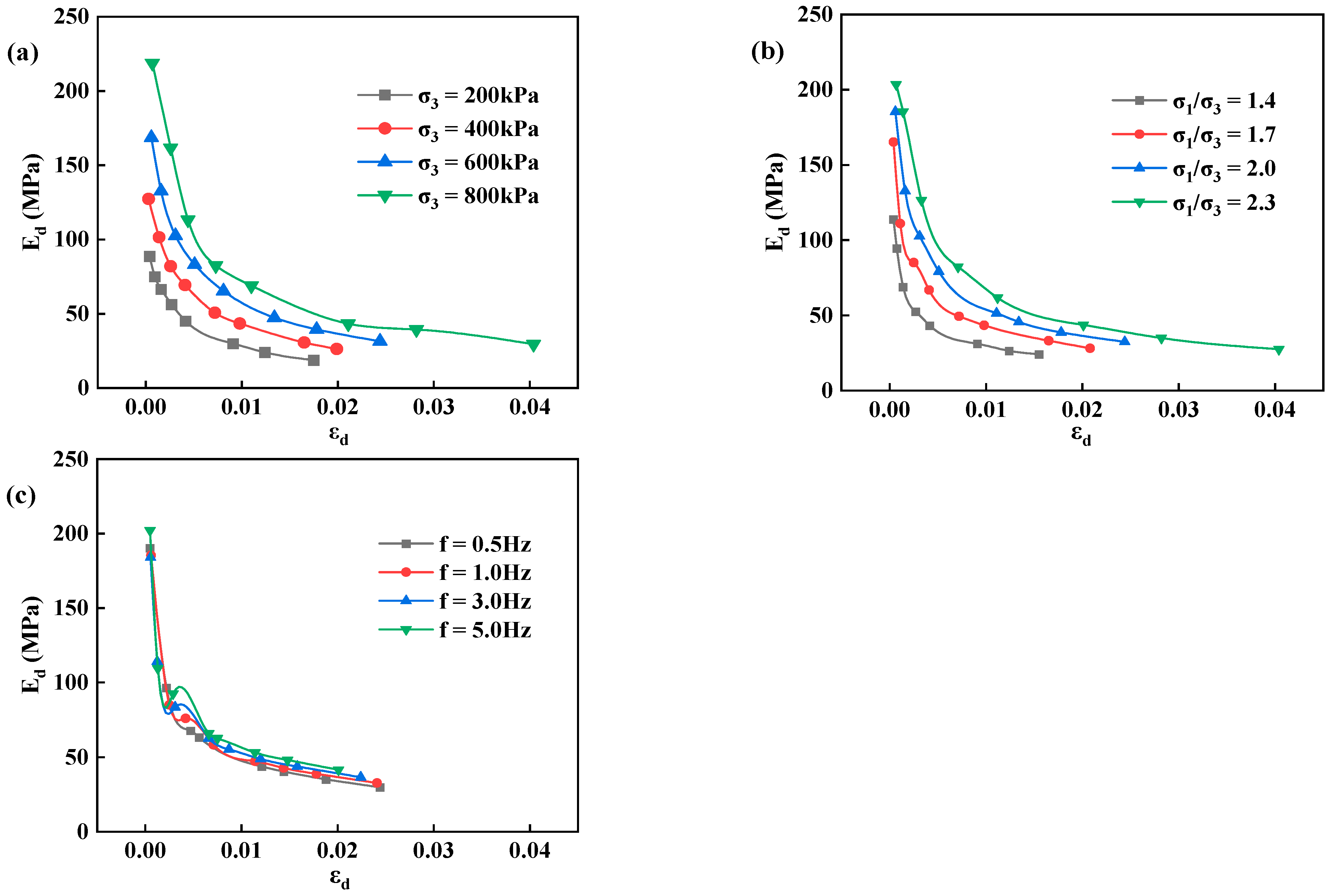

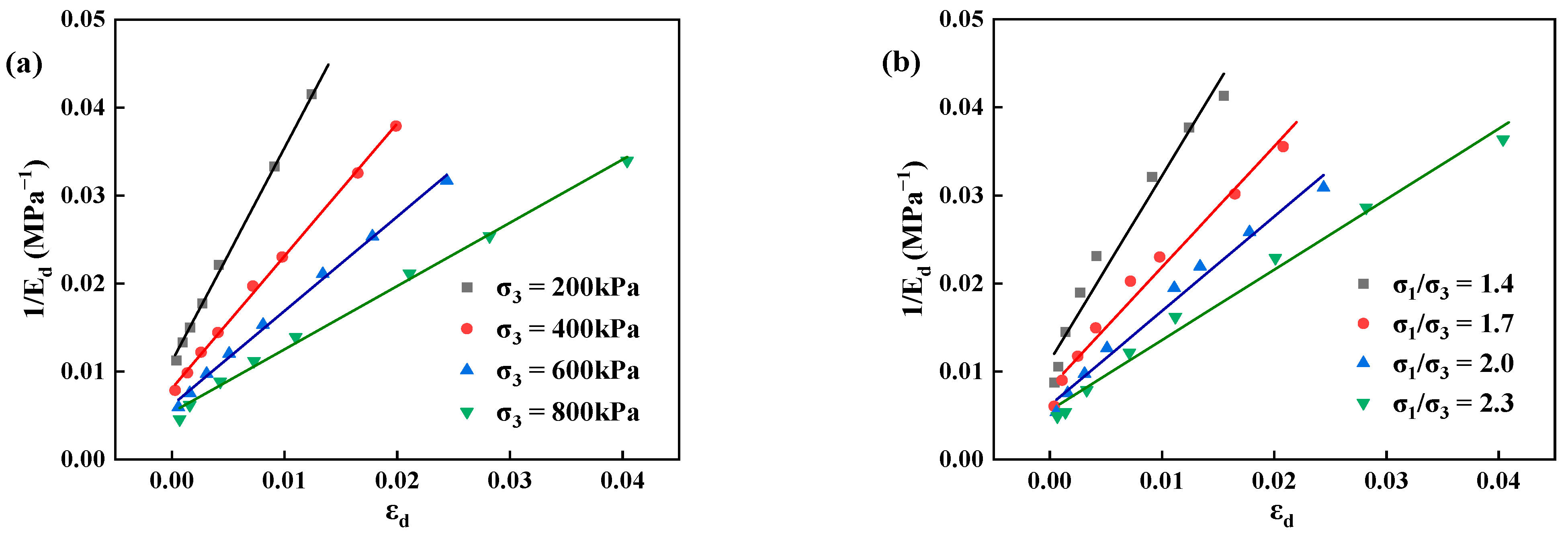
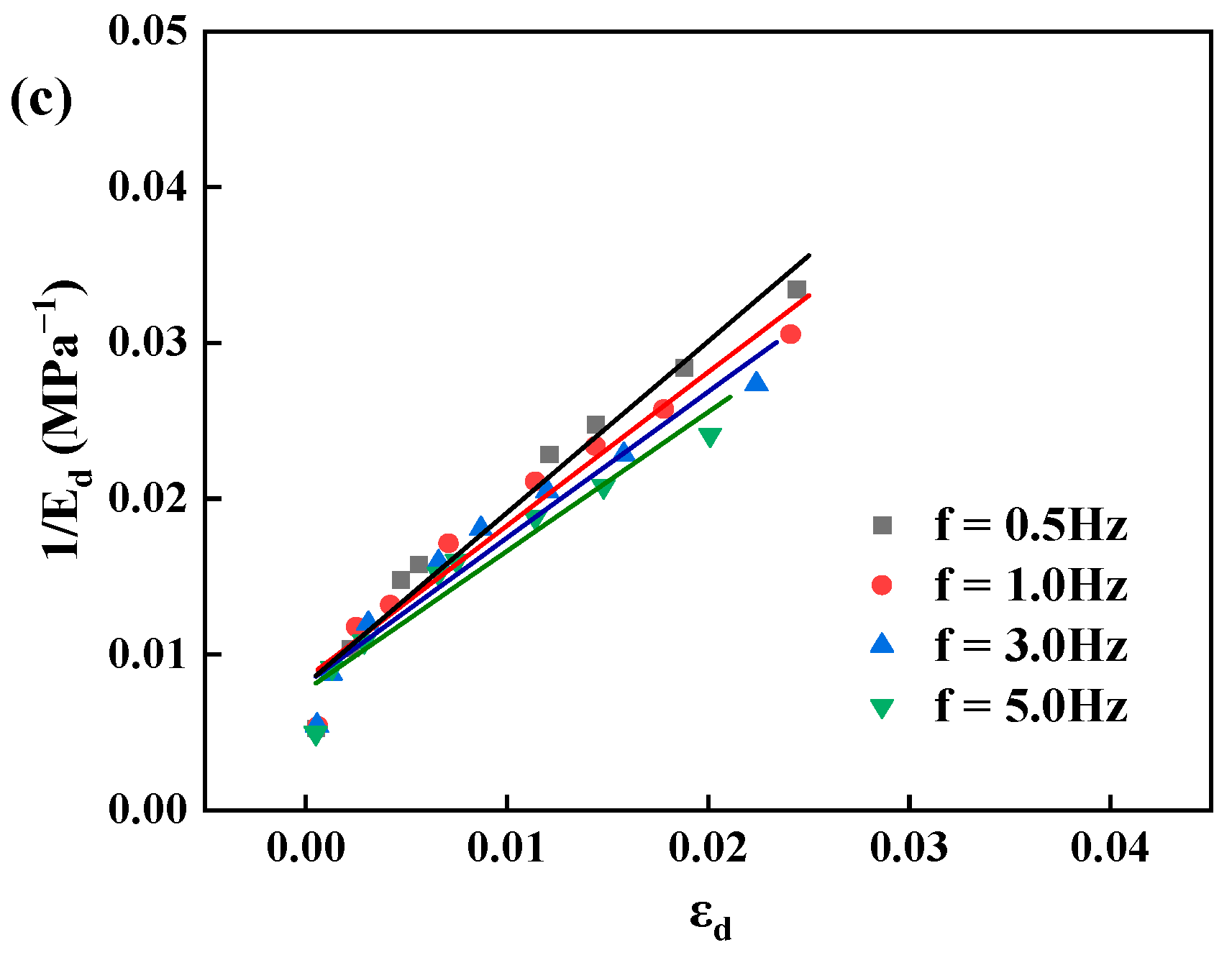
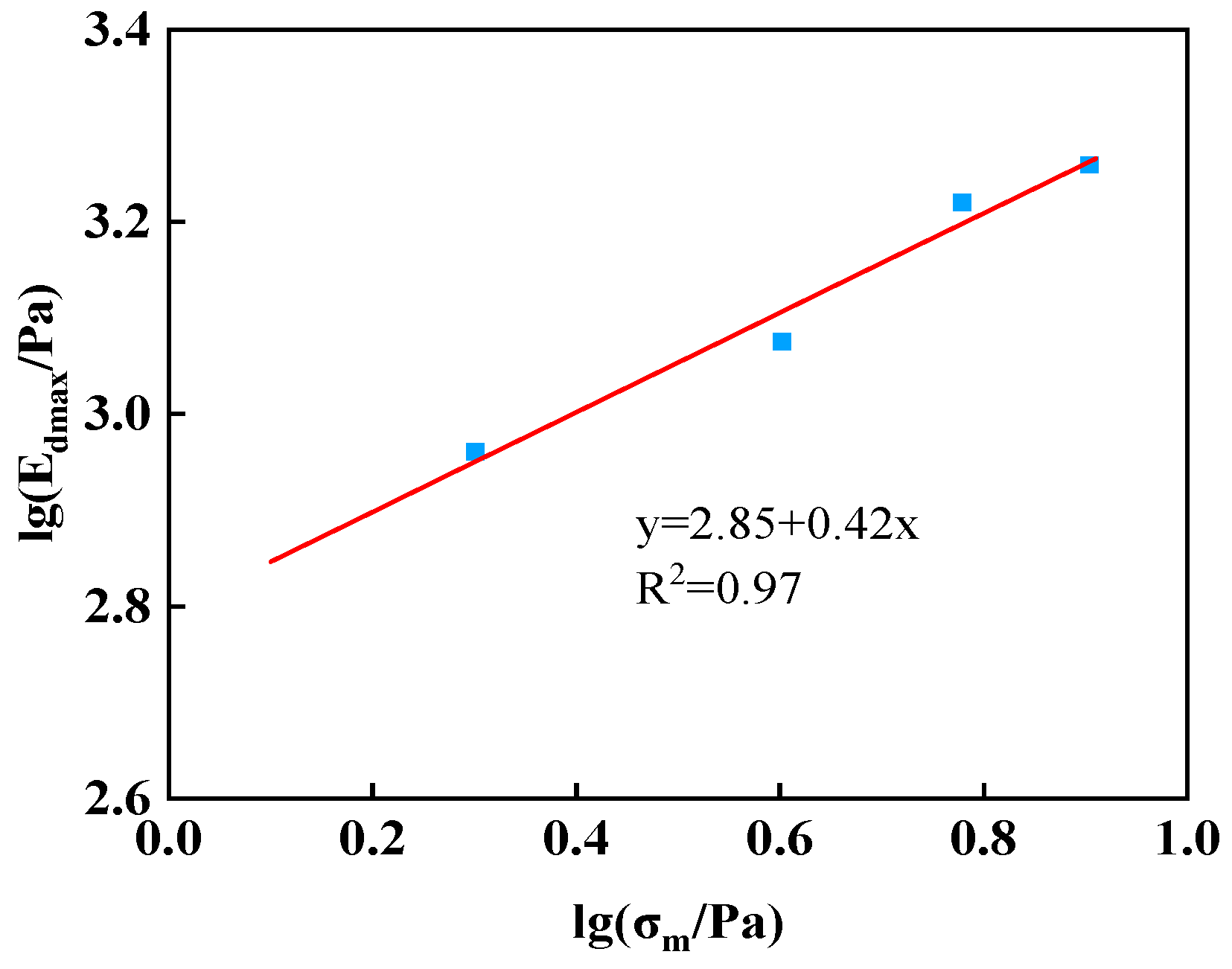



| Project | Proportion of Material Dosage (%) | ||||
|---|---|---|---|---|---|
| Types of materials | (9.5~19) mm | (4.75~9.5) mm | (2.36~4.75) mm | (0.075~2.36) mm | Filler dosage |
| Mixing ratio of mass | 23 | 15 | 15 | 35 | 12 |
| Test Properties | Unit | Standard | Test Result |
|---|---|---|---|
| Penetration (25 °C,100 g, 5 s) | 0.1 mm | 60~80 | 73.9 |
| Ductility (5 cm/min, 15 °C) | cm | ≥150 | 159 |
| Density (25 °C) | g/cm3 | - | 0.981 |
| Softening point | °C | ≥45 | 47.7 |
| loss by mass | % | ±0.8 | 0.031 |
| Residual ductility (5 cm/min, 15 °C) | cm | ≥80 | 90 |
| Residual penetration | % | ≥61 | 79 |
| Test Properties | Unit | Standard | Test Result (2.36~4.75) mm | Test Result (4.75~9.5) mm | Test Result (9.5~19) mm |
|---|---|---|---|---|---|
| Apparent density | g/cm3 | ≥2.6 | 2.7 | 2.67 | 2.73 |
| Crushing value | % | ≤30 | 9 | — | — |
| Water absorption | % | ≤2.0 | 0.4 | 0.1 | 0.1 |
| Mud content | % | ≤0.5 | 0.4 | 0.3 | 0.1 |
| Test Properties | Unit | Standard | Test Result |
|---|---|---|---|
| Apparent density | g/cm3 | ≥2.55 | 2.68 |
| Water absorption | % | ≤2.0 | 1.2 |
| Water stability level | grade | ≥6 | 9 |
| Mud content | % | ≤2 | 0.6 |
| Test Properties | Particle Size Range | Standard | Test Result |
|---|---|---|---|
| Fineness (%) | <0.6 mm | 100 | 100 |
| <0.15 mm | >90 | 99.72 | |
| <0.075 mm | >85 | 96.98 | |
| Apparent density (g/cm3) | ≥2.5 | 3.07 | |
| Hydrophilicity coefficient | ≤1.0 | 0.79 | |
| Rate of water conten | ≤0.5 | 0.02 | |
| Test Group Number | Confining Pressures (kPa) | Principal Stress Ratio | Vibration Frequencies (Hz) |
|---|---|---|---|
| WY1 | 200 | 2.0 | 1.0 |
| WY2 | 400 | 2.0 | 1.0 |
| WY3 | 600 | 2.0 | 1.0 |
| WY4 | 800 | 2.0 | 1.0 |
| YLB1 | 600 | 1.4 | 1.0 |
| YLB2 | 600 | 1.7 | 1.0 |
| YLB3 | 600 | 2.0 | 1.0 |
| YLB4 | 600 | 2.3 | 1.0 |
| PL1 | 600 | 2.0 | 0.5 |
| PL2 | 600 | 2.0 | 1.0 |
| PL3 | 600 | 2.0 | 3.0 |
| PL4 | 600 | 2.0 | 5.0 |
| Test Group Number | Confining Pressures (kPa) | Principal Stress Ratio | Vibration Frequencies (Hz) | Parameters | Fitted Value by Experimental Data (MPa) | |
|---|---|---|---|---|---|---|
| WY-1 | 200 | 2.0 | 1.0 | 0.0078 | 2.4915 | 128.2 |
| WY-2 | 400 | 2.0 | 1.0 | 0.0058 | 1.4443 | 172.4 |
| WY-3 | 600 | 2.0 | 1.0 | 0.005 | 1.0969 | 200.0 |
| WY-4 | 800 | 2.0 | 1.0 | 0.0045 | 0.8366 | 222.2 |
| YLB-5 | 600 | 1.4 | 1.0 | 0.0055 | 1.6541 | 181.8 |
| YLB-6 | 600 | 1.7 | 1.0 | 0.0052 | 1.3762 | 192.3 |
| YLB-7 | 600 | 2.0 | 1.0 | 0.0050 | 1.1524 | 200.0 |
| YLB-8 | 600 | 2.3 | 1.0 | 0.0048 | 0.9815 | 208.3 |
Disclaimer/Publisher’s Note: The statements, opinions and data contained in all publications are solely those of the individual author(s) and contributor(s) and not of MDPI and/or the editor(s). MDPI and/or the editor(s) disclaim responsibility for any injury to people or property resulting from any ideas, methods, instructions or products referred to in the content. |
© 2024 by the authors. Licensee MDPI, Basel, Switzerland. This article is an open access article distributed under the terms and conditions of the Creative Commons Attribution (CC BY) license (https://creativecommons.org/licenses/by/4.0/).
Share and Cite
Wang, J.; Tang, X.; Wu, Q.; Chen, C. Research on Multiple-Factor Dynamic Constitutive Model of Poured Asphalt Concrete. Materials 2024, 17, 3804. https://doi.org/10.3390/ma17153804
Wang J, Tang X, Wu Q, Chen C. Research on Multiple-Factor Dynamic Constitutive Model of Poured Asphalt Concrete. Materials. 2024; 17(15):3804. https://doi.org/10.3390/ma17153804
Chicago/Turabian StyleWang, Jianxiang, Xinjun Tang, Qin Wu, and Chuanxiang Chen. 2024. "Research on Multiple-Factor Dynamic Constitutive Model of Poured Asphalt Concrete" Materials 17, no. 15: 3804. https://doi.org/10.3390/ma17153804
APA StyleWang, J., Tang, X., Wu, Q., & Chen, C. (2024). Research on Multiple-Factor Dynamic Constitutive Model of Poured Asphalt Concrete. Materials, 17(15), 3804. https://doi.org/10.3390/ma17153804





